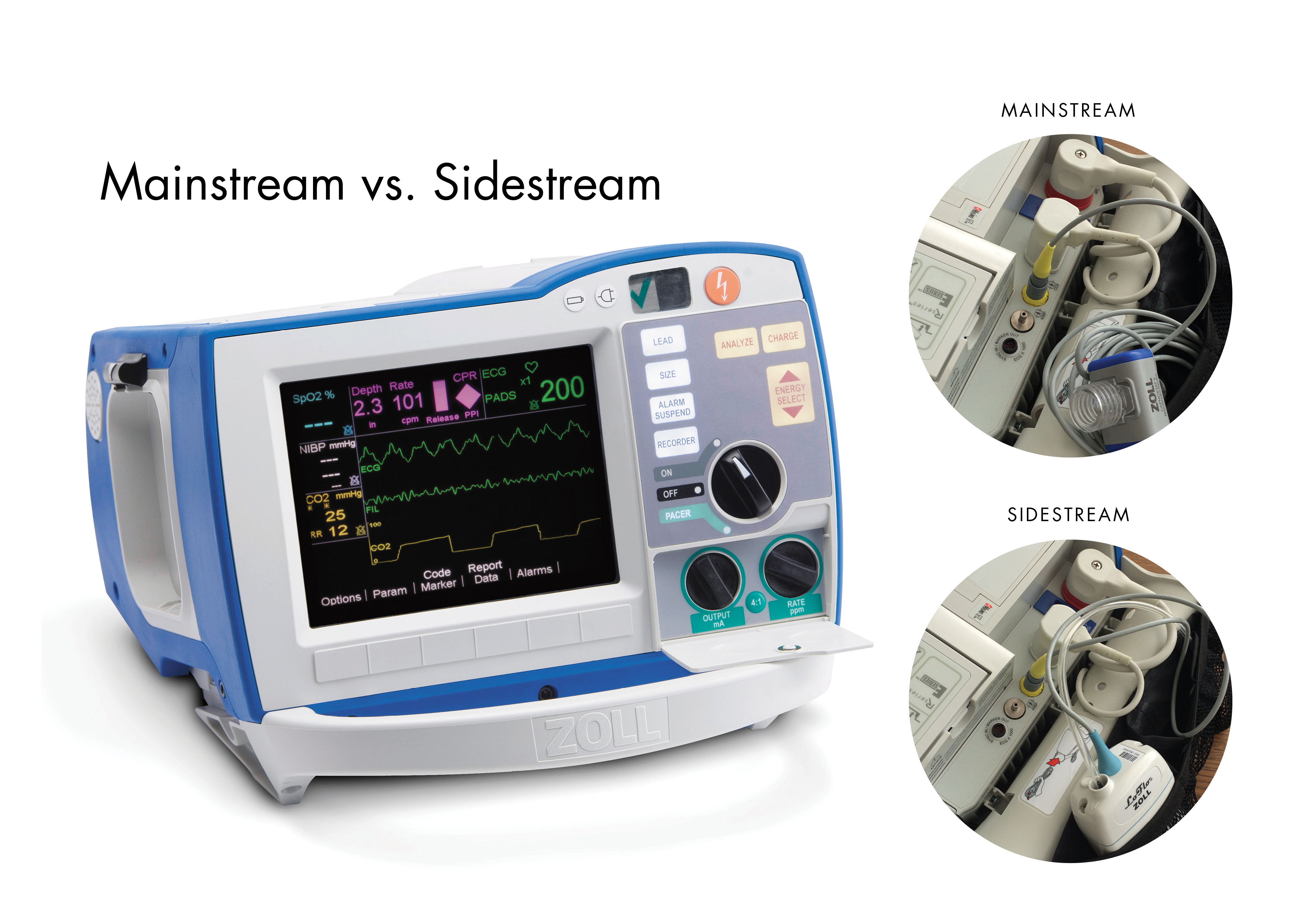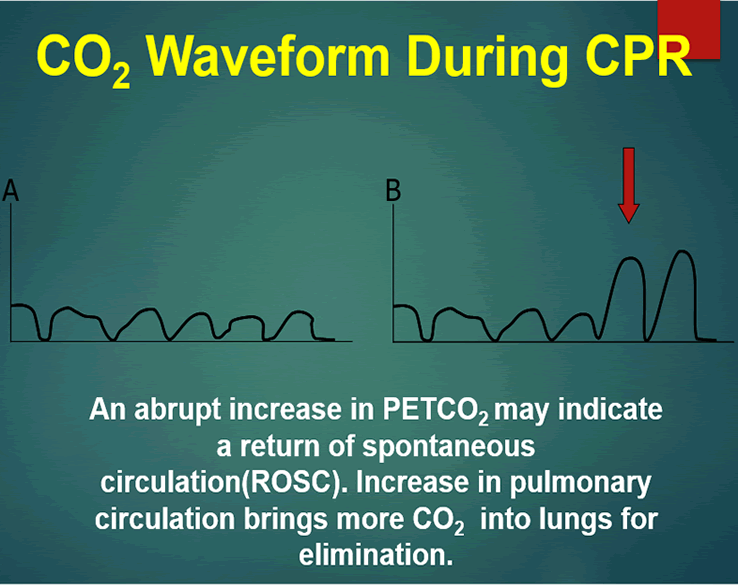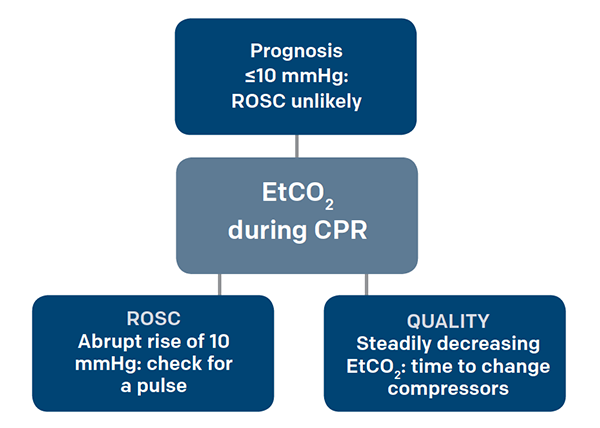low end tidal co2 during cpr
10 to 20 mmHg during CPR was strongly associated with ROSC while persistent EtCO2 below 10 to 20 mmHg after 20 minutes of CPR had a 05 likelihood of ROSC. Another use of ETco 2 monitoring is during procedural sedation and analgesia PSA.

End Tidal Co2 Emergency Medicine Icu Nursing Paramedic School
Ensure proper rate approximately 100min Ensure proper depth with adequate releaserecoil of thorax 12 thorax or minimum 25 inches Persistently low EtCO.

. End-tidal carbon dioxide monitoring ETCO2 has clinical uses far beyond solely determining hypo- or hyperventilation. Expect it to be as high as 60 mmHg when ROSC is achieved. The normal values are 5 to 6 CO2 which is equivalent to 35-45 mmHg.
Evidence suggests a persistently low ETco 2 value and a widened Paco 2-to-ETco 2 gradient during CPR are associated with poor outcomes. A rapid rise in EtCO 2 during CPR can indicate ROSC due to the improved oxygen delivery to tissues that were compromised during cardiac arrest. Thus ETco 2 monitoring is a noninvasive way to measure coronary artery blood flow and return of spontaneous circulation during CPR.
During CPR ETCO2 levels were initially high decreased to low levels and increased again at ROSC. These levels of CO 2 were consistent with effective chest compression generating reasonable pulmonary blood flow justifying continuation of resuscitation. We included randomized controlled trials cohort studies and case-control studies of adult cardiac.
4 to 5 CO2 PetCO2 vs. This non-invasive monitor can give valuable information about cardiac output perfusion and ventilation. Throughout the resuscitation end-tidal CO 2 was consistently in the 28-36 mmHg range during VFCPR.
Gradual fall in ETCO2 suggests compressionist fatigue during CPR - time to change compressionists. End-tidal carbon dioxide. Measurement of a low ETCO 2 value 10 mmHg during CPR in an intubated patient suggests that the quality of chest compressions needs improvement.
Continuous Waveform Capnograpy is written as PETCO2 which stands for patient end-tidal carbon dioxide. The height of the capnography waveform accompanies this number on the monitor as well as the. End-tidal carbon dioxide ETco2 monitoring provides valuable information about CO2 production and clearance ventilation.
With pulmonary embolism a blocked pulmonary artery causes less CO2-rich blood to return to the lungs and less CO2 is released with each breath. Cardio Pulmonary Resuscitation CPR ETCO2 concentration is a reliable index of effective heart compression during CPR which is associated with cardiac output 7 8The first sign of the return of spontaneous circulation ROSC during CPR is increase in ETCO2 therefore monitoring of ETCO2 provides very useful information to. Uses during cardiac arrest.
End-tidal carbon dioxide. It is the measurement of CO2 at the completion of exhalation and roughly correlates to the CO2 present in arterial blood. End-tidal CO2 ETCO2 detection requires air movement in and out of the lungs ventilation CO2 production from cellular metabolism and.
A sustained drop or low. What does end-tidal CO2 tell you. Why is ETCO2 low during CPR.
End-tidal CO2 EtCO2 monitoring is a noninvasive technique which measures the partial pressure or maximal concentration of carbon dioxide CO2 at the end of an exhaled breath which is expressed as a percentage of CO2 or mmHg. The amount of CO2 at the end of exhalation or end-tidal CO2 ETCO2 is normally 35-45 mm HG. Shortness of breath from anxiety-induced hyperventilation is caused by an excess of CO2 exhalation.
Loss of ETCO2 may be the first sign that CPR is needed. This pattern not previously described is different from that observed in animal and adult cardiac arrest caused by ventricular fibrillation during which ETCO2 decreases to almost zero after the onset of arrest begins to increase after the onset of effective CPR and increases to. 35-40 mm Hg PETCO2 less than 10 indicates ineffective chest compressions.
High quality CPR consistent waveform and end-tidal CO2 20 kPa. Low ETCO2 below 10 mm HG may be caused by either poor compression technique or from low perfusion and metabolism after a long downtime or shock despite good compressions. 20 mmHg at 20 minutes CPR - higher chance of ROSC.
To identify whether any level of end-tidal carbon dioxide ETCO2 measured during cardiopulmonary resuscitation CPR correlates with return of spontaneous circulation ROSC or survival in adults experiencing cardiac arrest in any setting. Low end tidal co2 during cpr. The height of the etco2 waveform during cpr has been used as an indirect measure of adequate chest compressions helping those involved in resuscitation monitor the effectiveness of their compressions in real time.
This will cause a decrease in the ETCO2 end-tidal CO2 and this will be observable on the waveform as well as with the numerical measurement. Two very practical uses of waveform capnography in CPR are. Abrupt increase in ETCO2 suggests ROSC during CPR detectable before pulse check ETCO2 at 20 minutes of CPR is prognostically useful.
Numerous studies have shown that abrupt increases in ETCO2 pressures exceeding 10 mmHg that remain higher than preceding values suggest an increase in cardiac output and is indicative of ROSC hence the incorporation of such measures in ACLS guidelines1 Patients with values less than 10 mmHg are more likely to die during CPR and. By measuring exhaled CO2 many types of pulmonary assessments can be made. Normal ETCO2 in the adult patient should be 35-45 mmHg.
Other respiratory conditions can cause a low ETCO2 reading or hypocapnea. Chest compression provider tiring end-tidal CO2 value diminishes over time. Rounded low rectangle EtCO 2 waveform during CPR with a high spike on ROSC.
Negative Epigastric sounds Equal lung sounds Esophageal detector. Goal is 10 mmHg during CPR. Patient end-tidal carbon dioxide.
PaCO2 PetCO2 End tidal measurement from expired or exhaled air PaCO2 Arterial blood gas sample End tidal normally 2-5 mmHg lower than arterial Comparing Arterial and End-tidal CO2 Review of Airway Confirmation Visualization Auscultation. 1 evaluating the effectiveness of chest compressions and 2 identification of ROSC. Average Etco2 Kpa During Cpr In Patients With Or Without Rosc Download Scientific Diagram.

Cpr Mobile Code Stand With Capnograph Capnography
Emdocs Net Emergency Medicine Educationcapnography In The Ed Emdocs Net Emergency Medicine Education

Capnography During Cardiopulmonary Resuscitation Current Evidence And Future Directions

3 Waveform Capnography Showing Changes In The End Tidal Carbon Dioxide Download Scientific Diagram

Etco2 Valuable Vital Sign To Assess Perfusion The Airway Jedi

Capnograph Note Try To Maintain Etco2 Above 10mmhg During Cpr Respiratory Therapy Student Nurse Anesthesia Emergency Nursing

Quantitative Waveform Capnography Acls Medical Training

R Series End Tidal Carbon Dioxide Etco2 Zoll Medical

The Impact Of Ventilation Rate On End Tidal Carbon Dioxide Level During Manual Cardiopulmonary Resuscitation Resuscitation

Use End Tidal Capnography For Placing Orogastric Nasogastric Tubes And Cpr Page 2 Of 4 Acep Now Page 2

The Role Of Etco2 In Termination Of Resuscitation Jems Ems Emergency Medical Services Training Paramedic Emt News

Average Etco2 Kpa During Cpr In Patients With Or Without Rosc Download Scientific Diagram

3 Waveform Capnography Showing Changes In The End Tidal Carbon Dioxide Download Scientific Diagram

Etco2 Valuable Vital Sign To Assess Perfusion The Airway Jedi

Use End Tidal Capnography For Placing Orogastric Nasogastric Tubes And Cpr Page 2 Of 4 Acep Now Page 2

Waveform Capnography In The Intubated Patient Emcrit Project
